- Details
- Hits: 1098
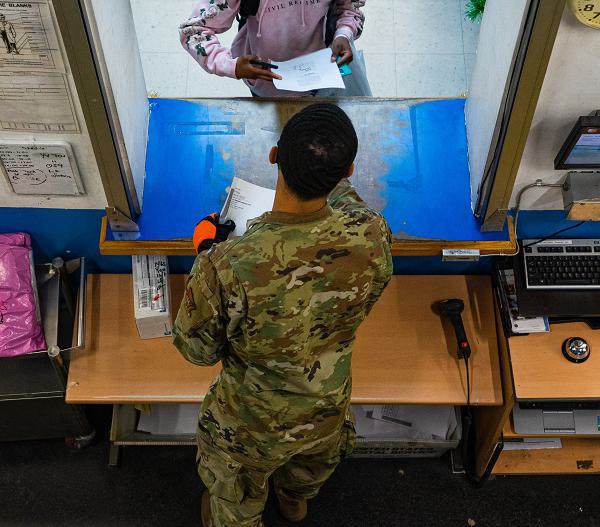
Osan Air Base Post Office, South Korea. (October 14, 2024): Forget Taylor Swift, in most units the battalion mail clerk is the most popular person and the most sought after. In this photo by 1st Lieutenant Daniel de La Fé, Airman 1st Class Damon Thompson, 51st Force Support Squadron postal clerk, helps a fellow Airman with an oversized package.
In many military units, postal clerks walk the base personally handing out the mail. This makes the Postal Clerk the most popular troop in the unit. Postal Clerks learned, through sheer repetition, everyone’s name in the battalion. Their arrival meant hope for mail from home or disappointment when it didn’t.
In the U.S., all mail services are consolidated under the Military Postal Services Agency or MPSA. The MPSA coordinates with the civilian U.S. Postal Service to oversee all military mail. The system is subsidized to ensure that military mail does not cost the sender any more than normal domestic mail. In some cases, military personnel in a combat zone may post letters and packages to their home country free of charge.
- Details
- Hits: 1231
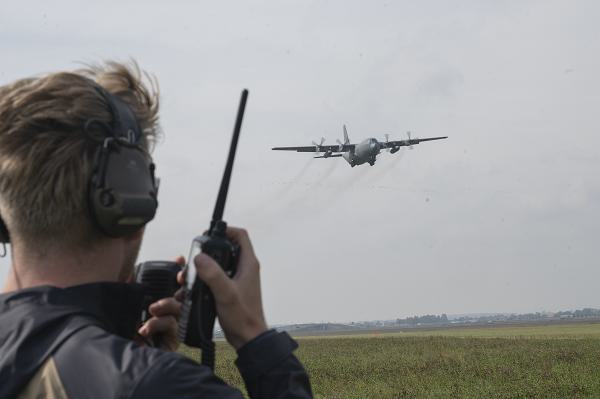
Leszno Airfield, Poland. (October 5, 2024): Imagine having a job where multiple lives and millions in military equipment is in your hands, where every decision you make is life or death. In this photo by Airman 1st Class Trevor Calvert, Air Force Staff Sergeant Brayden Crabtree, 86th Operations Support Squadron complex watch supervisor, guides an incoming Polish C-130H Hercules to a safe landing. SSgt. Crabtree has one of the top five most stressful jobs in the world… air traffic control.
Air Force air traffic controllers on the ground, also known as Air Traffic Control (ATC) specialists, are responsible for managing the flow of aircraft through all aspects of their flight. They direct the movement of aircraft into and out of military airfields by tracking planes by radar and giving voice instructions directly to the pilot from the ground.
The job can be harrowing.
ATCs must relay flight and landing instructions, weather reports, and safety information to pilots in real time. They plot an aircraft’s position and compute its speed, direction, and altitude. Unlike their civilian counterparts, Air Force ATCs must be ready to perform their duties in the haze of combat.
- Details
- Hits: 1753
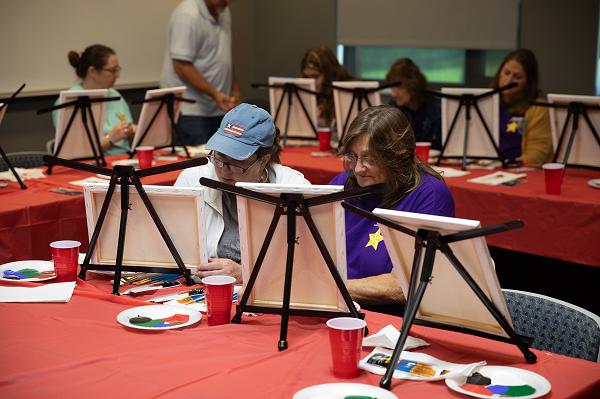
Kingwood, West Virginia. (October 9, 2024): America owes an eternal debt to Gold Star families who have made the ultimate sacrifice for our country. In this photo by National Guard Cadet Ayden Norcross, Gold Star family members paint canvases during the annual West Virginia National Guard Gold Star Families Weekend Retreat. The last Sunday of September is recognized as Gold Star Mother’s and Family’s Day.
A ”Gold Star” family is one in which a member has died or was killed during a war. The designation dates to World War I when families displayed small banners with either a blue or gold star outside their homes. A blue star was displayed for every immediate family member serving in the armed forces. If their service member was killed while serving in the military, the family placed a gold star over the blue star to let the community know of their loss.
In 1936, President Franklin D. Roosevelt established Gold Star Mother’s and Family’s Day and by 1947 the Gold Star Wives was established. Although the exact number of Gold Star families today is unknown, there are thousands of new Gold Star families from recent conflicts. According to a 2019 Military Times article, more than 16,000 troops have died in non-combat circumstances and more than 7,000 died in the Iraq and Afghanistan wars alone. They join thousands of living Gold Star Family members who lost loved ones in both World Wars, the Korean War, the Vietnam War, and Desert Shield/Storm.
- Details
- Hits: 1320
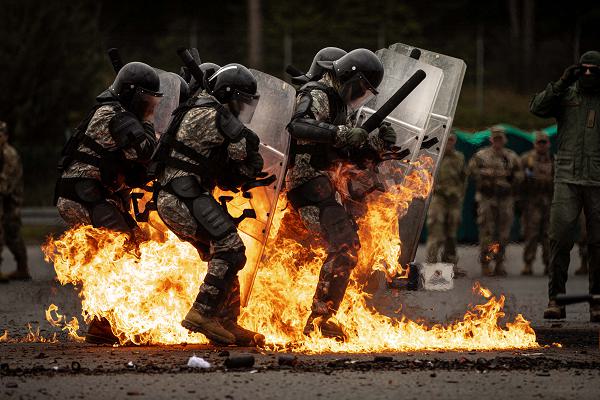
Hohenfels, Germany. (October 10, 2024): It is a fear as ancient as when cave dwellers realized fire’s destructive power and it is something Soldiers actively train to overcome. In this photo by Staff Sergeant Mickey Miller, Soldiers battle flames from a Molotov cocktail during fire phobia training. The training allows Soldiers to familiarize themselves with effective tactics and techniques for reacting to fire without panicking.
Held at the Joint Multinational Readiness Center, Fire Phobia training was created in 1999 in response to incidents involving U.S. Soldiers during peace keeping missions Kosovo, Yugoslavia. American units found themselves in a law enforcement role dealing with civil unrest and riot control. Crowds hurled Molotov Cocktails at U.S. and NATO troops which underscored a need for more training and equipment to protect our Soldiers. Today, groups of allied troops come to Hohenfels for a thorough “toasting” in carefully managed crowd-control drills.
Prior to each drill, Soldiers wear facemasks and various pads and strap-on body armor plates for protection from the heat. They are shown how to form tight formations behind riot shields and what to do if momentarily engulfed in flames. The training helps Soldiers overcome their natural fear of fire by introducing them to the proper procedures of reacting to a homemade incendiary device.
- Details
- Hits: 1088
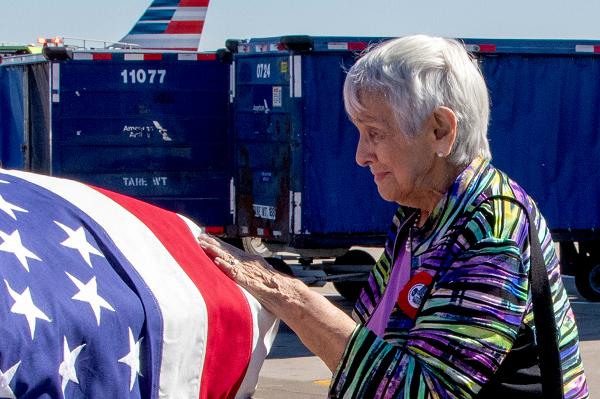
Chicago, Illinois. (October 11, 2024): Another of America’s greatest generation has finally made it home after nearly 84 years. In this photo by Barbara Wilson, Rosemarie Dillon, the 89-year-old niece of Army National Guard Private First Class Harry Jerele touches his flag-draped casket at O'Hare International Airport. Jerele was a World War II prisoner of war who died in captivity in 1943 and whose remains had recently been identified. Rosemarie Dillon was 5 years old when Jerele went overseas.
A member of the Illinois Army National Guard, PFC Jerele served with Company B of the 192nd Tank Battalion in the Pacific. In the summer 1942, Japanese forces invaded the Philippine Islands and despite a ferocious defense thousands of American troops, including Jerele, surrendered. What followed was one of the worst war crimes in history. Thousands of American and Filipino prisoners were subjected to an ordeal that came to known as the infamous Bataan Death March. The Japanese marched sick and wounded prisoners through sixty-five miles of steaming jungle, bayoneting those who fell behind. The survivors were incarcerated at the Cabanatuan POW camp where some 2,500 POW died during the war.
- Details
- Hits: 2688
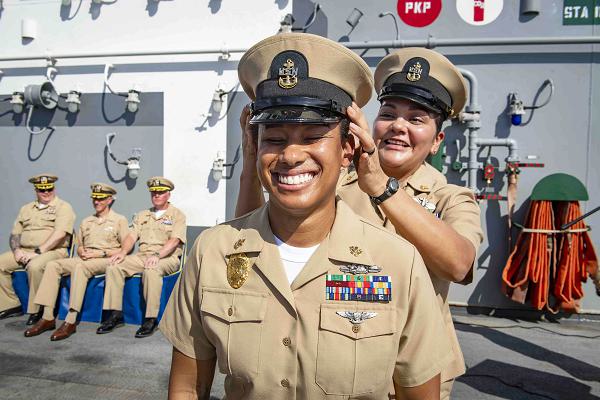
Pacific Ocean. (October 9, 2024): Senior NCOs are the essential link between officers and lower enlisted troops who are both supervisors and advocates. In this photo by Petty Officer 2nd Class Connor Burns, Chief Petty Officer Krystal Jones-Bostic receives her combination cover during a chief petty officer pinning ceremony aboard the USS Boxer. Jones-Bostic, a native of Detroit, joins the approximately 30,000 chief, senior chief, and master chief petty officers in the Navy. A chief petty officer is an E-7 enlisted rank that was established by the Navy in 1893 and is equivalent to a gunnery sergeant in the Marine Corps, a sergeant first class in the Army, and a master sergeant in the Air Force.
In the Navy and Coast Guard, advancement to chief petty officer not only carries requirements for time in service and superior evaluation scores, but candidates are also subject to peer review. This means a chief petty officer can only advance after review by a selection board of serving master chiefs. This is important in that superior test scores are not enough, a candidate must have the confidence of their fellow leaders.
With rank comes responsibility and these professionals are given more responsibilities than any other enlisted rank in the world. On average, it takes about thirteen years of active service to qualify for E-7 and this includes completing basic training, advancing through the enlisted ranks, and meeting the necessary requirements for promotion to chief petty officer (There are three chief petty officer ranks: chief petty officer, senior chief petty officer, and master chief petty officer).


